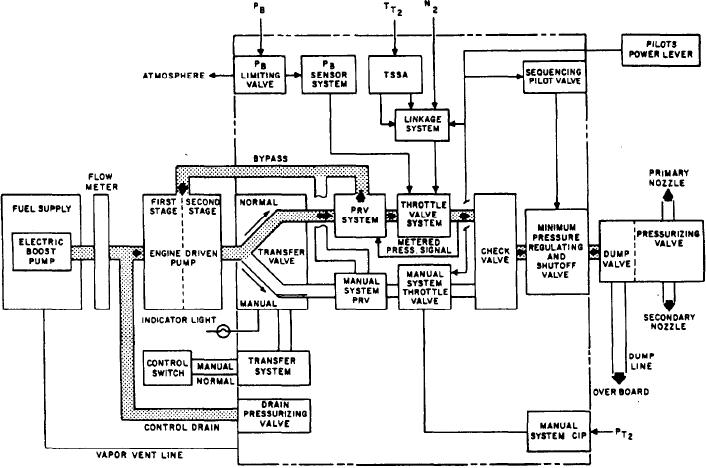
Figure 4-16.-Fuel control (JFC 25-3).
of the control, the fuel is filtered by a coarse
maintain the selected pressure drop. The pressure-
regulating-valve sensor also incorporates a
(80-mesh) screen and a fine (40-micron) screen.
bimetallic disc to compensate for any variation
The coarse screen protects the metering system
from large particles of fuel contaminants. If this
in the specific gravity of the fuel, which results
from fuel temperature change.
screen becomes clogged, a filter relief valve will
The high-pressure fuel, as regulated by the
open, permitting continued operation with
pressure-regulating valve, then passes through the
unstrained fuel. The fine screen protects the
throttle valve. This valve consists of a contoured
computing system against solid contaminants.
plunger that is positioned by the computing sys-
This screen is self-cleaning. It traps particles by
removing the high-velocity of the fuel flowing past
tem of the control within a sharp-edged orifice. By
virtue of the constant pressure drop maintained
the screen into the metering section.
Next, the fuel encounters the pressure-reg-
across the throttle valve, fuel flow is a function
of the plunger position. An adjustable stop limits
ulating valve, which is designed to maintain a
the motion of this plunger in the decrease fuel
constant pressure differential across the throttle
valve. All high-pressure fuel in excess of that
direction to permit minimum fuel flow.
The final part to act upon the metered flow
required to maintain this pressure differential is
prior to its exit from the control is the minimum
bypassed to the pump interstage by the pressure-
pressure and shutoff valve. This valve is designed
regulating valve. This valve is servo controlled.
to shut off the flow of metered fuel to the engine
The actual pressure drops across the throttle valve
when the power lever is in the OFF position. This
orifice and is compared, by the sensor, with
causes the power-lever-operated sequencing valve
a selected pressure drop, and any error is
to transmit a high-pressure signal to the spring
hydraulically amplified. The amplified error
side of the shutoff valve. This forces the latter
positions the pressure-regulating-valve spring,
against the seat, thus shutting off the flow of fuel
altering the force balance of this valve so that
to the engine. When the power lever is moved out
sufficient high-pressure fuel is bypassed to
4-21

